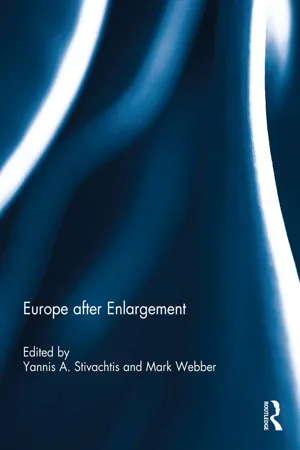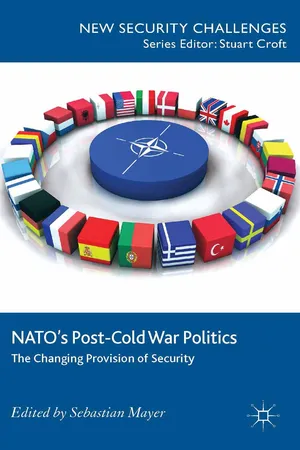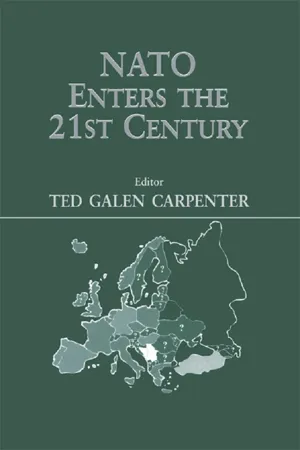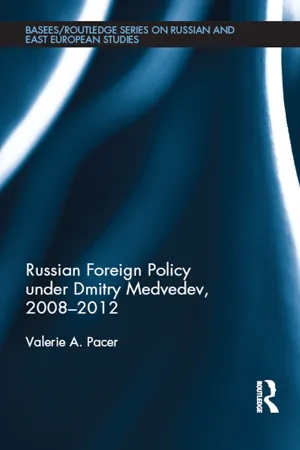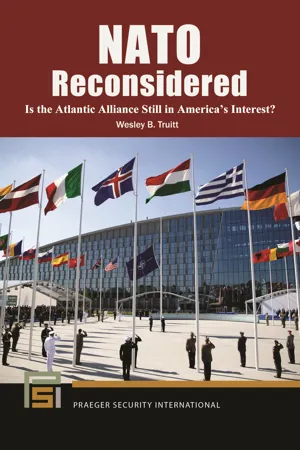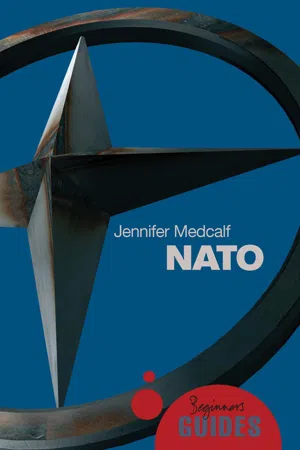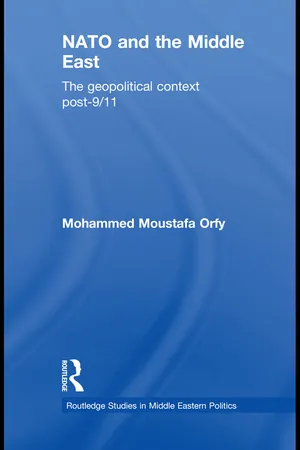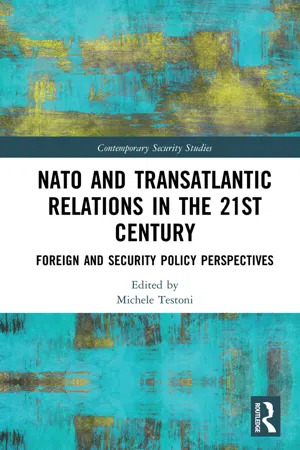History
The Formation of NATO
The formation of NATO, the North Atlantic Treaty Organization, occurred in 1949 as a response to the growing threat of Soviet expansion in Europe after World War II. The alliance was established to provide collective defense against potential aggression and to promote stability and security in the region. NATO's formation marked a significant shift in international relations and had a lasting impact on the geopolitics of the Cold War era.
Written by Perlego with AI-assistance
Related key terms
Related key terms
1 of 4
Related key terms
1 of 3
10 Key excerpts on "The Formation of NATO"
- eBook - ePub
- Yannis Stivachtis, Mark Webber(Authors)
- 2017(Publication Date)
- Routledge(Publisher)
NATO: Within and Between European International Society MARK WEBBERDepartment of Politics and International Studies, University of Birmingham, UKABSTRACT NATO’s role in forging European order is undeniable, but the clarity and focus of Alliance purpose has changed considerably since the end of the Cold War. The ramifications of this change are considered via analysis of the trajectory of enlargement and a conceptualisation of the enlarged Alliance based upon English School thinking. Four categories are put forward: these refer to geographic levels of operation, conditionality, legitimacy and great-power management. The argument which emerges from this treatment is that NATO was and remains an essential component of European regional international society but its centrality has been modified both by developments consequent upon the end of the Cold War and the political fall-out of the events of 9/11.Enlargement of the Alliance
The North Atlantic Treaty, the basis upon which the North Atlantic Treaty Organization (NATO) was formed, refers in Article X to the possibility of accession. Tellingly, this is the only part of the Treaty which expressly requires unanimity. The solemn nature of the commitments which flowed from membership, the disputed credentials of certain founding allies (Italy and Portugal), and the assumption that any future candidates would provoke controversy all meant that full agreement be built in to the Treaty as a means of safeguarding Alliance unity. Intra-NATO disagreement preceded the accessions which followed over the next four decades, but in each case this eventually dissipated owing either to special arrangements (as in the Paris accords of 1954 which overcame French concerns surrounding German accession) or to an awareness of strategic and political necessity. Thus, Greek and Turkish membership in 1952 was facilitated by the Korean War, while Spain’s belated accession in 1982 was made possible by the development of the ‘second Cold War’ and the consolidation of the post-Franco transition (Smith 2000, 71–2, 147–51, 157). - eBook - ePub
NATO's Post-Cold War Politics
The Changing Provision of Security
- S. Mayer, S. Mayer, S. Mayer(Authors)
- 2014(Publication Date)
- Palgrave Macmillan(Publisher)
Against the background of dramatic circumstances in early 1948, the North Atlantic Treaty Organization (NATO) was constituted to institutionalize a defence arrangement. In view of East–West tensions eventually turning into a serious confrontation between the Western powers and the Soviet Union, France, Great Britain, and the US realized that their existing collective and bilateral arrangements (above all the Marshall Plan and US bilateral military aid) were insufficient and had to be sustained by a politico–strategic institution (Schmidt 2003: 87, 233–240). West Europeans therefore called upon the US, hitherto hostile to alliances, to negotiate what would eventually become the North Atlantic Treaty of 4 April 1949 (NAT), NATO’s founding document. That treaty constitutes a primarily political arrangement which largely relied on the deterrence effect of both a unity of purposes and principles among the allies (policy of strength) and on the overwhelming US military might, including nuclear weapons and strategic bombers.In this opening chapter to the historical part of the volume I outline NATO’s emerging political structure primarily with reference to two focal issues: firstly, the credibility of the US security guarantee under the impact of the changing structures of the evolving US–USSR arms race as well as the role of the US in making NAT(O) work;1 and secondly, the question whether the quest of western European states for politico–strategic and economic integration would suffice to make up for Europe’s deficiencies of defence arrangements (such as the Brussels Pact) before NATO was established.The link between these two grand themes was the concurrence of both US and west European convictions that NATO alone was unable to warrant the ‘Security of the West’ due to inevitable conflicts about the issue of nuclear deterrence. As we shall see below, the Alliance had therefore to be complemented by endeavours to promote and organize ‘European unity’ (Schmidt 1995a: 144). Some proponents of ‘uniting Europe’, like US President Eisenhower and his Secretary of State John F. Dulles (Neuss 2000), had in mind that the US eventually could and should reduce its presence as a ‘European’ (conventional) military power to the extent to which western Europe recovered (Cromwell 1992).The remainder of this chapter starts by elucidating the roots of NATO. First I discuss the most crucial institutional structures the Alliance was built upon, partially in benefiting from existing alliances (particularly the Western Union Defence Organisation, WUDO). In the second section, I outline the NAT and assess how the implementation of some of its articles affected the emergence of NATO’s politico– administrative structure. The third section discusses the significance of non-military cooperation in the founding of NATO. Next, the emerging Annual Review process is examined. In the fifth section, I proceed by discussing the emerging instrument of political consultation. The penultimate section reviews The Formation of NATO’s permanent politico– administrative unit, including its Secretary General, while the last raises the issue of a number of challenges to NATO as an independent international organization. - Bruce A. Arrigo(Author)
- 2016(Publication Date)
- SAGE Publications, Inc(Publisher)
R. James Orr R. James Orr Orr, R. JamesNorth Atlantic Treaty Organization* North atlantic treaty organization*689 696North Atlantic Treaty Organization*
The North Atlantic Treaty Organization (NATO) is a collective defense alliance that came into being as a response to the devastation of the two World Wars and the fear that humankind would not survive a third. Originally founded in response to the threat posed by the Soviet Union, the creation of the alliance was part of a broader effort to serve three fundamental purposes: (1) deterring Soviet expansionism, (2) forbidding the revival of nationalist militarism in Europe through a strong North American presence on the continent, and (3) encouraging European political integration.*- eBook - ePub
- Ted Galen Carpenter(Author)
- 2013(Publication Date)
- Routledge(Publisher)
11 More specifically, the widely held view in Washington in the late 1940s maintained thatif the Soviets overran Western Europe and harnessed the vast resources of that region to their own war machine, they could confront America as an equal in terms of military-industrial potential. If it were not for nuclear weapons, this great Soviet-dominated bloc might well be unconquerable, and indeed might in the long run be more than a match for the United States.12The architects of the NATO alliance lived through the years spanning World War I, the interwar period, and World War II. Sobered by the events of that calamitous period, those men recognized the folly behind collective security. In designing the NATO Charter, US diplomats and their Canadian and European counterparts recognized that the glue holding any alliance together came in the form of a shared and specific threat. On 4 April 1949, representatives of 12 nations met in Washington, and created the North Atlantic Treaty Organization.In signing the NATO Charter, the North American and West European governments committed themselves to function in accordance with the concept of collective defense. The signatories did not forfeit the right to control the destinies of their foreign policies, nor did they radically alter the manner in which they defined and protected their national interests. Rather, the member states all agreed that, with regard to one aspect of their foreign policies, their interests coincided, and they agreed to establish a joint mechanism for advancing a shared goal. While the Soviet Union was not mentioned in the Charter, there was no doubt that Article 5, the key passage, spoke directly to the Soviet threat. As Article 5 read in 1949, and as it reads unchanged today: - Valerie Pacer(Author)
- 2015(Publication Date)
- Routledge(Publisher)
Trenin, 2011b : 91). This divergence of opinions among the NATO member-states has had an important role in shaping the opinion of the Russian leaderships on the alliance.For the countries of Eastern Europe, membership in NATO after the collapse of the Warsaw Pact meant that their countries were under the American security umbrella (Lucas, 2008 : 130). In her 2002 speech after Latvia was invited to join NATO, the Latvian president, Vaira Vike-Freiberga, said that after the loss of the country’s independence following World War II ‘being invited in[to] an Alliance that will ensure our security is a momentous moment that will be writ large in the history of our nation’ (Vike-Freiberga, 2002 ). Although not speaking about concerns of any threat her country faced, the president’s statement reflects the appeal that NATO has to the countries of Eastern Europe because of the collective defence mechanism. Despite the concerns of some NATO member-states about the risk that Russia poses to their country, for most Europeans even the 2008 Russia–Georgia conflict did not prompt concerns that Russia represents a threat and, in fact, many countries of the region sought to further develop their relations with Russia, particularly their economic relationships given Russia’s plentiful natural resources (Krickus, 2009 ). As one Central European ambassador stated, the declaration in the 2010 NATO Strategic Concept that ‘NATO poses no threat to Russia’ was a case of ‘stating the obvious’. Putin has argued against the idea that Russia presents a threat to other countries and stated that ‘nobody is afraid of us and I don’t think it would be easy for us to scare anyone’ (Putin, 2001a- eBook - ePub
NATO Reconsidered
Is the Atlantic Alliance Still in America's Interest?
- Wesley B. Truitt(Author)
- 2020(Publication Date)
- Praeger(Publisher)
CHAPTER 7NATO’s Relevance to the United States in Today’s Changing World Order
“There is no arc of history that ensures that America’s free political and economic system will automatically prevail. Success or failure depends upon our actions.”1President Donald J. TrumpThe United States is the only global superpower. It has economic interests in virtually every part of the world. Its security interests mirror those economic interests. It also has the material means to safeguard those interests. No other country today has these characteristics because America is the wealthiest country on earth and the most powerful.The United States has fought aggression, liberated conquered people, secured peace, and fostered the security and prosperity of other nations for one hundred years. While so doing, it has spent its own blood and treasure, taken no territory, and seized no property of others. It has established and supported international institutions that foster peace and security, open markets, economic development, democratic values, and human rights.Among those institutions is the North Atlantic Treaty Organization (NATO). It is an American invention intended to secure the peace and safety of democracies first in Western Europe and later throughout most of Europe. It achieved its purpose. Those democracies have grown safe and prosperous under the security of NATO, backed by the power of the United States.Given NATO’s peaceful victory over the Soviet Union in 1991, the question has been asked, why was NATO continued and not dissolved at that time?Harvard Professor Stephen Walt asks the same question, “Having won the Cold War and achieved a position of primacy unseen since the Roman Empire, why did U.S. leaders decide to maintain a military establishment that dwarfed all others and expand an already far-flung network of allies, client states, military bases, and security commitments?” Walt further asks, “Instead of greeting the defeat of its principal rival as an opportunity to reduce America’s global burdens, why did both Democrats and Republicans embark on an ill-considered campaign to spread democracy, markets, and other liberal values around the world?” Walt’s answer: “Instead of pursuing a more restrained grand strategy, U.S. leaders opted for liberal hegemony because the foreign policy community believes spreading liberal values is both essential for U.S. security and easy to do.”2 - eBook - ePub
The 'Double Democratic Deficit'
Parliamentary Accountability and the Use of Force Under International Auspices
- Heiner Hänggi(Author)
- 2017(Publication Date)
- Routledge(Publisher)
Among intergovernmental institutions NATO takes pride of place. Over the years it developed into a permanent consultation machinery for its members and through its 'Partnership for Peace' (PfP) programme extended security cooperation throughout the Euro-Atlantic area, which now includes the republics emerging from the former Soviet Union. Its integrated military structure provided a role for all allies and achieved impressive results in terms of common practices, joint operating procedures and rules of engagement. Even in operations which were not commanded by NATO as such, but conducted on the basis of a coalition of the able and willing, NATO procedures were the fabric facilitating joint action. This paper analyses the characteristics of the NATO system and its decision-making with special emphasis on the parliamentary dimension. For illustrating the parliamentary dimension, three case studies are selected which dominated NATO's decision-making in the last decade: the enlargement process, Kosovo as an example of a NATO military intervention, and the adaptation of NATO's Strategic Concept (with special emphasis on out-of-area operations). In each case, special attention is given to the role of the NATO Parliamentary Assembly (NATO PA) and how it tries to influence NATO decision-making. In each case it was apparent that parliamentary control in the strict sense of the word exclusively rested with national parliaments. In this respect NATO was not different from other intergovernmental organisations. Where it differed, however, was US leadership, the emphasis on multilateral review procedures which put national commitments in a comprehensive system of defence planning and a well-oiled bureaucratic system capable of dealing with crises in problem-solving. The international parliamentary dimension grew into a consensus-building network of committee meetings, visits and reports within the NATO PA which, until 2001, was called the North Atlantic Assembly, providing national parliamentarians with important information they could use in their own parliamentary debates. The contacts between parliamentarians from Europe and North America in particular, provided a basis of common understanding and assessment which became essential in mustering political support for the major decisions taken by the North Atlantic Council.The chapter concludes with some comments on the November 2002 Prague Summit, which not only dealt with the next round of enlargement, but also took decisions in the light of changed strategic realities and the new significance of the fight against terrorism.Decision-Making in NATO
Decision-making in NATO is an intergovernmental negotiating process with special characteristics. It is regular and frequent; with bottom-up and top-down elements; its Secretary General and secretariat have a strong position but at the same time the US exercises a leadership role; it is consensus-based, but usually a great effort is made to find a compromise between different views and interests; it is politico-military in nature with both parallel lines of authority and cross links between the political and military bodies; it contains significant mutual examination and review processes; it does not depend on meetings of ministers, as the Permanent Council possesses full decision-making authority in between ministerial sessions; and, finally, it has a parliamentary dimension (see NATO, 2001; Gallis, 2003). All these points will be examined below. - eBook - ePub
NATO
A Beginner's Guide
- Jennifer Medcalf(Author)
- 2012(Publication Date)
- Oneworld Publications(Publisher)
In fact, an out-of-area dimension was present from NATO’s inception, as, from very early on, the impact of the Cold War was not restricted solely to Western Europe, nor even to the North Atlantic area. The outbreak of war in Korea in June 1950, for instance, not only compelled the Allies to turn their attention from the European continent to events far beyond but also provided the impetus for the transformation of NATO into a permanent, integrated, military structure, set in motion the West European re-armament programme and caused American troops to return to Western Europe in large numbers. In spite of this early influence, there was disagreement from the outset among the Allies about the role NATO should play in addressing conflicts beyond its members’ territory. 3 One of the main reasons for Cold War disagreement were the formulations contained in the North Atlantic Treaty, which specified that the Article 6 geographic boundaries applied ‘for the purpose of Article 5’. Achilles comments, in this respect, ‘the treaty area, as defined in Article 6, is simply that in which an armed attack would constitute a casus belli : there was never the slightest thought in the mind of the drafters that it should prevent collective planning, manoeuvres or operations south of the Tropic of Cancer in the Atlantic Ocean, or in any other area important to the security of the Parties ’. 4 This conclusion echoes that of the then Secretary of State, Dean Acheson, who in a press conference in March 1949 stated that the North Atlantic Treaty contained ‘no limiting clause’ to prevent the allies from undertaking military action following ‘an attack to security outside the treaty area’. 5 The terms of the North Atlantic Treaty did not preclude NATO engagement beyond the parameters stipulated in Article 6, but simply did not make it obligatory - eBook - ePub
- Mohammed Moustafa Orfy(Author)
- 2010(Publication Date)
- Routledge(Publisher)
2 NATO’s new global role and its relevance to the Middle EastThis chapter focuses on the new role of the North Atlantic Alliance and its relevance to the Middle East region. The term ‘new’ is understood as the wholesale transformation of the Alliance and expansion of its area of interest, laid down by the 1949 Washington Treaty, in the post-Cold War world. To be sure, member states began the transformation process even before the demise of the former Soviet Union. It is work that continues until now, profoundly changing NATO from a Cold War collective security mechanism into a new organisation that takes a holistic approach to dealing with pressing security issues, attaching key importance to the political dimension. The whole transformation process has run, to a great extent, in parallel with the core postulates of liberal institutionalism. The aim of what follows is to evaluate the major trends of the transformation process and their bearing upon on the Middle East, as well as to show how the chosen theoretical framework has informed this process. In particular, this is made clear with respect to the impact of the two main strategic concepts as well as the two major vehicles of the transformation process – ‘enlargement’ and ‘Partnership for Peace’.Developments in the 1990s
The 1991 Strategic Concept
As the North Atlantic Alliance started its transformation process, it was necessary and unavoidable to change its long-standing guiding principles. Consequently, at a meeting of the North Atlantic Council in Rome in 1991, heads of state and government, while reaffirming the basic principles and concepts of the Alliance, approved and adopted the first ever published NATO Strategic Concept.1 Its content can be summarised as follows:1 The North Atlantic Alliance is purely defensive in purpose; NATO’s policy is based on the collective defence and indivisible security of member allies. Previously, the allies reassured the former Soviet Union, at the London Summit in 1990,2 that ‘We will remain a defensive Alliance and will continue to defend all the territory of all our members … we have no aggressive intention … we will never in any circumstances be the first to use force’.3 - eBook - ePub
NATO and Transatlantic Relations in the 21st Century
Foreign and Security Policy Perspectives
- Michele Testoni, Michele Testoni(Authors)
- 2020(Publication Date)
- Routledge(Publisher)
Firstly, Italy’s exposure to the volatility and uncertainties of the post-Cold War system, which made it imperative not to loosen ties with the US. Secondly, a widespread belief that, as enshrined in article 2 of the North Atlantic Treaty, NATO is more than a defensive military alliance: it is a community among liberal–democratic states, which share a communitarian, liberal–democratic identity, based upon a common set of norms, values, and practices. Thirdly, NATO remained the main vector for the modernization of the Italian armed forces, and for keeping them interoperable and technologically up-to-date with those of more militarily advanced allies. Fourthly, also after the end of the Cold War membership of the Alliance continued to act a means of winning allied prestige and recognition and of retaining a say in the key decisions that shape the international system. As a result, in the early 1990s Italy firmly placed itself among those countries willing to revitalize the Alliance for the contingencies of the post-Cold War world. In 1991, Rome fully endorsed the adoption of a New Strategic Concept, which envisioned the prospect of “out-of-area” engagements in peacekeeping and crisis management operations. The possibility of NATO’s intervention to manage conflicts in unstable areas close to Italy’s borders, such as the Balkans and North Africa, was aimed at dealing with the fragmented contingencies of the post-Cold War world, while preventing the risk of “entrapment” in neighboring crises. 10 Loyalty to NATO also reflected fears about an emerging Franco-German axis in Europe, which might condemn Italy to the rank of a secondary power and exclude Rome from the debate on the reform of the UN Security Council. 11 In other words, also after the end of the East–West division Italian decisionmakers perceived the Alliance as a guarantee that Italy would continue to sit at the table when decisions in as crucial a field as European security were made
Index pages curate the most relevant extracts from our library of academic textbooks. They’ve been created using an in-house natural language model (NLM), each adding context and meaning to key research topics.
Explore more topic indexes
Explore more topic indexes
1 of 6
Explore more topic indexes
1 of 4
